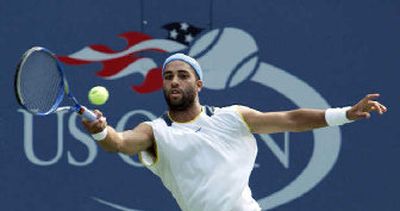Blake takes emotional victory

NEW YORK – Misfortune’s victim for so long, James Blake punctuated the Hollywood-like turnaround of his life and career by upsetting French Open champion Rafael Nadal on Saturday at the U.S. Open.
Blake, who sank to No. 210 in the rankings last spring and needed a wild-card invitation to get into the Open, knocked off the No. 2 Nadal, 6-4, 4-6, 6-3, 6-1, as cheers, mixed with more than a few tears, cascaded down from his friends in packed Arthur Ashe Stadium.
“I need a new vocabulary to describe how I felt about that match,” Blake’s mother, Betty, said. “This time last year he was half-paralyzed and watching this on TV and wondering if he’d ever play tennis again. How good is that? It’s like you can’t describe how good that is. To see him smile the way he did is wonderful for a mom.”
Blake was overwhelmed by the constant cheers of his buddies – “The James Block” – and the more than 20,000 fans in the stadium, who gave him a long, warm ovation at the end.
“I truly wish every single person in here could have the feeling I have now,” he told them.
If it weren’t the biggest win of the 25-year-old Blake’s career – in his mind nothing will top his victory over Andre Agassi three years ago en route to his first tour title in Washington – it put him into the fourth round of the U.S. Open for the first time, matched his best performances in Grand Slam events and set him up for a possible quarterfinal confrontation against Agassi.
Agassi, seeded No. 7, had a tough time against No. 32 Tomas Berdych but reached the fourth round with a 3-6, 6-1, 6-4, 7-6 (2) victory.
In other matches, No. 8 Guillermo Coria and No. 13 Richard Gasquet advanced, as did women’s No. 2 Lindsay Davenport, No. 3 Amelie Mauresmo, No. 6 Elena Dementieva, No. 7 Justine Henin-Hardenne, No. 11 Patty Schnyder, No. 12 Mary Pierce, No. 15 Nathalie Dechy and No. 19 Elena Likhovtseva, who beat 2004 French Open champion and No. 13 Anastasia Myskina.
“If someone had told me a year ago that I’d have to go out and lose love, love and love in the quarterfinals of the Open to Andre Agassi, I’d say, I’d take it in a heartbeat,” Blake said. “If that happens, so be it. I’m going to go out there and play the same way I’ve been playing, not be afraid. Today I was not afraid to play Rafael Nadal. I will not be afraid to play Andre.”
The match between Blake and Nadal, two of the speediest players in tennis, gyrated around brilliant shots by each of them in the first two sets. One moment, Blake scurried to catch up to balls that seemed out of reach, the next moment Nadal did the same.
Everything changed on two astonishing points that Blake won, the first on a running lob that he flicked crosscourt into the corner to break Nadal in the third set for a 3-2 lead, the second a series of shots that broke Nadal for the set and crushed the Spaniard’s spirit.
Nadal, the winner of nine tournaments this year and usually so cocky, sagged and never recovered as Blake steamrolled him in the fourth set.
“I lost confidence,” said the 19-year-old Nadal, who proved he could win on hard courts when he captured his first title on the surface in Montreal last month, beating Agassi in the final.
To anyone familiar with Blake’s story of tragedy and perseverance – and that included his many friends and family and nearly everyone else in the stadium – the sight of him taking down the best young player on the tour was as emotional as it gets.
Only 16 months ago, Blake didn’t know if would play tennis again after he fractured vertebrae in his neck when he crashed into a net post during practice in Rome. Yet, ever positive, he spun that bad luck around and said it was the best thing that happened to him because it allowed him to spend time with his father, Tom, who was dying of cancer. His father died in July last year.
A week later, Blake contracted shingles, which temporarily paralyzed his face and caused vision and hearing problems. Again he looked on the bright side, wondering what he would do with his life if his athletic career were to end. It was an attitude that served him well when he was 13 and was diagnosed with scoliosis, a severe curvature of the spine, which forced him to wear a back brace 18 hours a day.